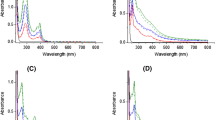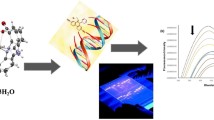Abstract
This work is focused on the study of DNA binding and cleavage properties of 2′-deoxyadenosines modified with ester/amide of histidine (his6dA ester, his6dA amide) and their copper(II) complexes. To determine the coordination mode of the complex species potentiometric and spectroscopic (UV–visible, CD, EPR) studies have been performed. The analysis of electronic absorption and fluorescence spectra has been used to find the nature of the interactions between the compounds and calf thymus DNA (CT-DNA). There is significant influence of the –NH2 and –OCH3 groups on binding of the ligands or the complexes to DNA. Only amide derivative and its complex reveal intercalative ability. In the case of his6dA ester and Cu(II)–his6dA ester the main interactions can be groove binding. DNA cleavage activities of the compounds have been examined by gel electrophoresis. The copper complexes have promoted the cleavage of plasmid DNA, but none of the ligands exhibited any chemical nuclease activity. The application of different scavengers of reactive oxygen species provided a conclusion that DNA cleavage caused by copper complexes might occur via hydrolytic pathway.











Similar content being viewed by others
References
Hadjiliadis N, Sletten E (eds) (2009) Metal complex-DNA interactions. Willey Publishing, Chippenham
Casassas E, Izguierdo-Ridorsa A, Tauler R (1990) J Inorg Biochem 39:327–336
Hollenstein M, Hipolito ChJ, Lam CH, Perrin DM (2009) ChemBioChem 10:1988–1992
Hollenstein M, Hipolito ChJ, Lam CH, Perrin DM (2009) Nucleic Acids Res 37:1638–1649
Smuga D, Majchrzak K, Sochacka E, Nawrot B (2010) New J Chem 34:934–948
Lodyga-Chruscinska E, Sierant M, Pawlak J, Sochacka E (2013) QScience 38:1–11
Irving HM, Miles MG, Pettit LD (1967) Anal Chim Acta 38:475–488
Gans P, Sabatini A, Vacca A (1985) J Chem Soc. Dalton Trans 6:1195
Alderighi L, Gans P, Ienco A, Peters D, Sabatini A, Vacca A (1999) Coord Chem Rev 184:311–318
Transformation protocol using heat shock MFT, 11/21/03. http://web.stanford.edu/~teruel1/Protocols/pdf/Transformation%20Protocol%20Using%20Heat%20Shock.pdf
Wolfe A, Shimer G, Meehan T (1987) Biochemistry 26:6392–6396
Jeyalkshmi K, Selvakumaran N, Bhuranesh NSP, Sreecanth A, Karvembu R (2014) RSC Adv 4:17179–17195
Ragheb MA, Eldesouki MA, Mohamed MS (2015) Spectrochim Acta Part A 138:585–595
Łodyga-Chruścińska E, Ołdziej S, Sochacka E, Korzycka K, Chruściński L, Micera G, Sanna D, Turek M, Pawlak J (2011) J Inorg Biochem 105:1212–1219
Sarathy RP, Ohrt JM, Chheda GB (1977) Biochemistry 16:4999–5008
Łodyga-Chruscinska E, Sochacka E, Smuga D, Chruściński L, Micera G, Sanna D, Turek M, Gąsiorkiewicz M (2010) J Inorg Biochem 104:570–575
Ren R, Yang P, Zheng W, Hua Z (2000) Inorg Chem 39:5454–5463
Kirin SI, Happel ChM, Hrubanova S, Weyhermüller T, Klein Ch, Metzler-Nolte N (2004) Dalton Trans 1201–1207. doi:10.1039/B313634E
Lodyga-Chruscinska E, Symonowicz M, Sykula A, Bujacz A, Garribba E, Rowinska-Zyrek M, Oldziej S, Klewicka E, Janicka M, Krolewska K, Cieslak M, Brodowska K, Chruscinski L (2015) J Inorg Biochem 143:34–47
González-Álvarez M, Alzuet G, Borrás J, Pitié M, Meunier B (2003) J Biol Inorg Chem 8:644–652
He J, Hu P, Wang Y-J, Tong M-L, Sun H, Mao ZW, Li L-N (2008) Dalton Trans 3207–3214. doi:10.1039/B801549J
Chen XQ, Peng XJ, Wang JY, Wang Y, Wu S, Zhang LZ, Wu T, Wu YK (2007) Eur J Inorg Chem 2007:5400–5407
Dimiza F, Perdih F, Tangoulis V, Turel I, Kessissoglou DP, Psomas G (2011) J Inorg Biochem 105:476–489
Mandal D, Chauhan M, Arjmand F, Aromi G, Ray D (2009) Dalton Trans 9183–9191. doi:10.1039/B909249H
Shahabadi N, Kashanian S, Khosravi M, Mahdavi M (2010) Transition Met Chem 35:699–705
Arjmand F, Jamsheera A, Mohapatra DK (2013) J Photochem Photobiol, B 121:75–85
Bei Q (2012) Chin J Struct Chem 31:1187–1193
Selvakumar B, Rajendiran V, Uma Maheswari P, Stoeckli-Evans H, Palaniandavar M (2006) J Inorg Biochem 100:316–330
Ramakrishnan S, Rajendiran V, Palaniandavar M, Periasamy VS, Srinag BS, Krishnamurthy H, Akbarsha MA (2009) Inorg Chem 48:1309–1322
Li XW, Li XJ, Li YT, Wu ZY, Yan CW (2013) J Photochem Photobiol B 118:22–32
Indumathy R, Radhika S, Kanthimathi M, Weyhermuller T, Nair BU (2007) J Inorg Biochem 101:434
Kahrovic E, Zahirovic A, Turkusic E (2014) J Chem Chem Eng 8:335–343
Qian J, Ma X, Tian J, Gu W, Shang J, Liu X, Yan S (2010) J Inorg Biochem 104:993–999
Acknowledgments
Financial support of this work by Statute Funds No. I28/DzS/9184.
Author information
Authors and Affiliations
Corresponding authors
Electronic supplementary material
Below is the link to the electronic supplementary material.
Rights and permissions
About this article
Cite this article
Borowska, J., Sierant, M., Sochacka, E. et al. DNA binding and cleavage studies of copper(II) complexes with 2′-deoxyadenosine modified histidine moiety. J Biol Inorg Chem 20, 989–1004 (2015). https://doi.org/10.1007/s00775-015-1282-2
Received:
Accepted:
Published:
Issue Date:
DOI: https://doi.org/10.1007/s00775-015-1282-2




